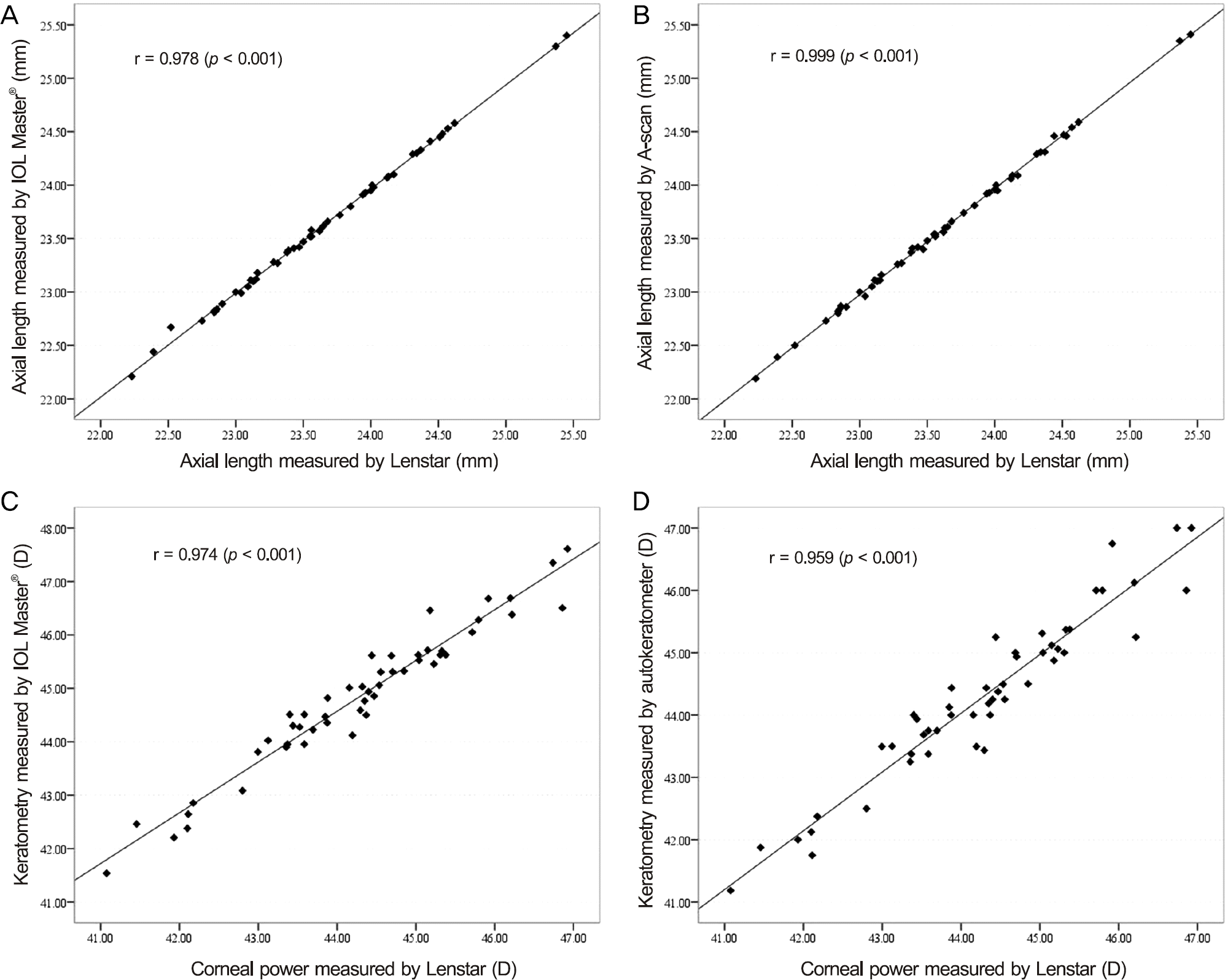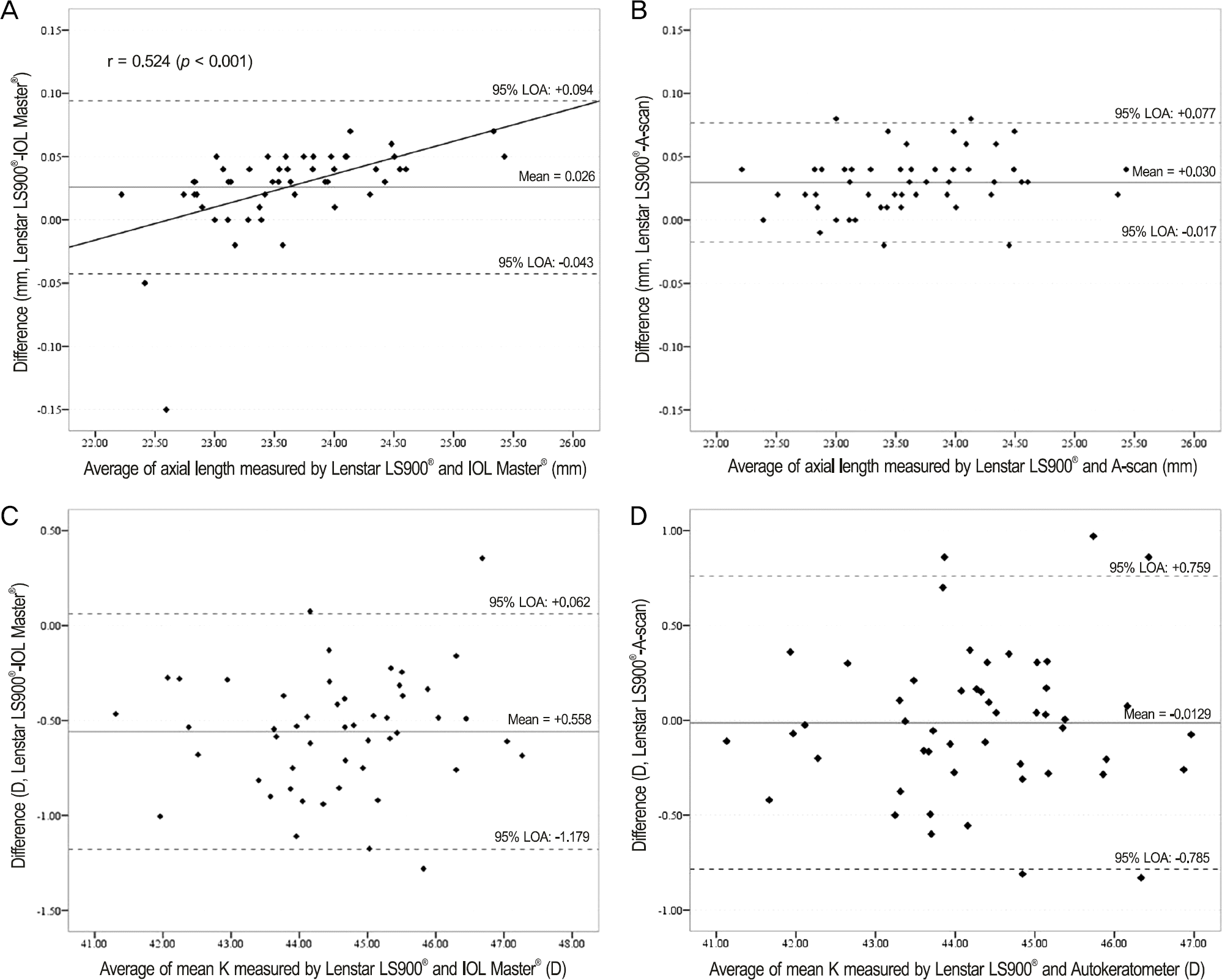Abstract
Purpose
To compare axial length (AL) and keratometry (K) using optical low-coherence reflectometry (OLCR, Lenstar LS900®, Haag- Streit, Bern, Switzerland) with current ocular biometry devices and evaluate the accuracy of intraocular lens (IOL) power calculation.
Methods
In this prospective, comparative observational study of eyes with cataracts, AL and K were measured using an OLCR device (Lenstar LS900®, Haag-Streit), partial coherence interferometry (PCI, IOL Master®, Carl Zeiss, Jena, Germany), A-scan (Eyecubed) and automated keratometry (KR-7100, Topcon, Tokyo, Japan). IOL power calculation was performed using the Sanders-Retzlaff-Kraff (SRK/T) formula. The IOL prediction error (PE) was calculated by subtracting the predicted IOL power from the postoperative (PO) IOL power (PO 4 weeks, PO 12 weeks).
Results
A total of 50 eyes of 39 patients with cataracts (mean age 67.12 ± 8.51 years) were evaluated in this study. AL and K were not significantly different between the OLCR device and other devices (analysis of variance [ANOVA], p = 0.946, 0.062, re-spectively). The mean PE in IOL power calculation was -0.22 ± 0.50D with the OLCR device, 0.08 ± 0.45D with the PCI device and -0.01 ± 0.48D with A-scan and automated keratometry (ANOVA, p = 0.006). The highest percentage of eyes with PE smaller than ± 0.5D was IOL Master® followed by Eyecubed and then Lenstar LS900®. The mean absolute PE was not statistically sig-nificant among the 3 devices (ANOVA, p = 0.684).
Go to : 
References
1. Santodomingo-Rubido J, Mallen EA, Gilmartin B, Wolffsohn JS. A new non-contact optical device for ocular biometry. Br J Ophthalmol. 2002; 86:458–62.

2. Hill W, Angeles R, Otani T. Evaluation of a new IOLMaster algo-rithm to measure axial length. J Cataract Refract Surg. 2008; 34:920–4.

3. Drexler W, Findl O, Menapace R. . Partial coherence inter-ferometry: a novel approach to biometry in cataract surgery. Am J Ophthalmol. 1998; 126:524–34.

4. Lam AK, Chan R, Pang PC. The repeatability and accuracy of axial length and anterior chamber depth measurements from the IOLMaster. Ophthalmic Physiol Opt. 2001; 21:477–83.
5. Haigis W, Lege B, Miller N, Schneider B. Comparison of im-mersion ultrasound biometry and partial coherence interferometry for intraocular lens calculation according to Haigis. Graefes Arch Clin Exp Ophthalmol. 2000; 238:765–73.

6. Buckhurst PJ, Wolffsohn JS, Shah S. . A new optical low co-herence reflectometry device for ocular biometry in cataract patients. Br J Ophthalmol. 2009; 93:949–53.

7. Rohrer K, Frueh BE, Wälti R. . Comparison and evaluation of ocular biometry using a new noncontact optical low-coherence reflectometer. Ophthalmology. 2009; 116:2087–92.

8. Zhao J, Chen Z, Zhou Z. . Evaluation of the repeatability of the Lenstar and comparison with two other non-contact biometric de-vices in myopes. Clin Exp Optom. 2013; 96:92–9.

9. Chen YA, Hirnschall N, Findl O. Evaluation of 2 new optical bio-metry devices and comparison with the current gold standard biometer. J Cataract Refract Surg. 2011; 37:513–7.

10. Hoffer KJ, Shammas HJ, Savini G. Comparison of 2 laser instru-ments for measuring axial length. J Cataract Refract Surg. 2010; 36:644–8.

11. Holzer MP, Mamusa M, Auffarth GU. Accuracy of a new partial coherence interferometry analyser for biometric measurements. Br J Ophthalmol. 2009; 93:807–10.

12. Retzlaff JA, Sanders DR, Kraff MC. Development of the SRK/T intraocular lens implant power calculation formula. J Cataract Refract Surg. 1990; 16:333–40.

13. Jasvinder S, Khang TF, Sarinder KK. . Agreement analysis of LENSTAR with other techniques of biometry. Eye (Lond). 2011; 25:717–24.

14. Salouti R, Nowroozzadeh MH, Zamani M. . Comparison of the ultrasonographic method with 2 partial coherence interferometry methods for intraocular lens power calculation. Optometry. 2011; 82:140–7.

15. Shin JW, Seong M, Kang MH. . Comparison of ocular bio-metry and postoperative refraction in cataract patients between Lenstar(R) and IOL Master(R). J Korean Ophthalmol Soc. 2012; 53:833–8.
16. Mehravaran S, Asgari S, Bigdeli S. . Keratometry with five dif-ferent techniques: a study of device repeatability and inter-device agreement. Int Ophthalmol. 2014; 34:869–75.

17. Huynh SC, Mai TQ, Kifley A. . An evaluation of keratometry in 6-year-old children. Cornea. 2006; 25:383–7.

18. Whang WJ, Byun YS, Joo CK. Comparison of refractive outcomes using five devices for the assessment of preoperative corneal power. Clin Experiment Ophthalmol. 2012; 40:425–32.

19. Carney LG, Mainstone JC, Henderson BA. Corneal topography and myopia. A cross-sectional study. Invest Ophthalmol Vis Sci. 1997; 38:311–20.
20. Speicher L. Intra-ocular lens calculation status after corneal re-fractive surgery. Curr Opin Ophthalmol. 2001; 12:17–29.

21. Bjeloš Ronč ević M, Bušić M, Cima I. . Intraobserver and inter-observer repeatability of ocular components measurement in cata-ract eyes using a new optical low coherence reflectometer. Graefes Arch Clin Exp Ophthalmol. 2011; 249:83–7.

22. Stattin M, Zehetner C, Bechrakis NE, Speicher L. Comparison of IOL-Master 500 vs. Lenstar LS900 concerning the calculation of target refraction: a retrospective analysis. Ophthalmologe. 2015; 112:444–50.
Go to : 
 | Figure 1.Correlation between biometric data (axial length, keratometry) measured by Lenstar LS900® and other devices (Pearson correlation analysis). Axial length measured by Lenstar LS900® and IOL Master® (A) and A-scan (B). Keratometry measured by Lenstar LS900® and IOL Master® (C) and autokeratometer (D). |
 | Figure 2.Bland-Altman plot of axial length between Lenstar LS900® and IOL Master® (A), Lenstar LS900® and A-scan (B), kera-tometry between Lenstar LS900® and IOL Master® (C), Lenstar LS900® and autokeratometer (D). LOA=limit of agreement. |
Table 1.
Comparison of biometric data (axial length, keratometry) by Lenstar LS900®, IOL Master®, A-scan and automated keratometry
| Lenstar LS900® | IOL Master® | A-scan | Automated keratometry | p-value* | |
|---|---|---|---|---|---|
| Axial length (mm) | 23.63 ± 0.71 | 23.58 ± 0.68 | 23.60 ± 0.70 | - | 0.946 |
| Keratometry (D) | |||||
| K1 | 43.77 ± 1.40 | 44.18 ± 1.32 | - | 43.86 ± 1.40 | 0.302 |
| K2 | 44.78 ± 1.39 | 45.49 ± 1.42 | - | 44.71 ± 1.33 | 0.009 |
| Average K | 44.27 ± 1.36 | 44.83 ± 1.33 | - | 44.29 ± 1.34 | 0.062 |
Table 2.
Comparison of PE among LS900®, IOL Master® and A-scan
| Lenstar LS900® | IOL Master® | A-scan | p-value* | ||
|---|---|---|---|---|---|
| PE (D) | |||||
| 4 weeks | -0.15 ± 0.47 | 0.15 ± 0.43 | 0.07 ± 0.44 | 0.003 | |
| 12 weeks | -0.22 ± 0.50 | 0.08 ± 0.45 | -0.01 ± 0.48 | 0.006 | |
| Absolute PE (D) | |||||
| 4 weeks | 0.41 ± 0.27 | 0.34 ± 0.30 | 0.34 ± 0.28 | 0.388 | |
| 12 weeks | 0.41 ± 0.36 | 0.36 ± 0.27 | 0.37 ± 0.30 | 0.684 | |
| Range (D) | |||||
| 4 weeks | -1.30~1.02 | -0.69~1.25 | -0.96~1.28 | ||
| 12 weeks | -1.28~1.00 | -0.76~1.21 | -0.93~1.28 | ||
| Eyes within (%) | |||||
| ±0.25D | 4 weeks | 34 | 46 | 52 | |
| 12 weeks | 44 | 46 | 46 | ||
| ±0.5D | 4 weeks | 70 | 80 | 84 | |
| 12 weeks | 68 | 78 | 70 | ||
| ±1.0D | 4 weeks | 94 | 94 | 96 | |
| 12 weeks | 91 | 98 | 98 | ||
| ±1.5D | 4 weeks | 100 | 100 | 100 | |
| 12 weeks | 100 | 100 | 100 | ||




 PDF
PDF ePub
ePub Citation
Citation Print
Print


 XML Download
XML Download